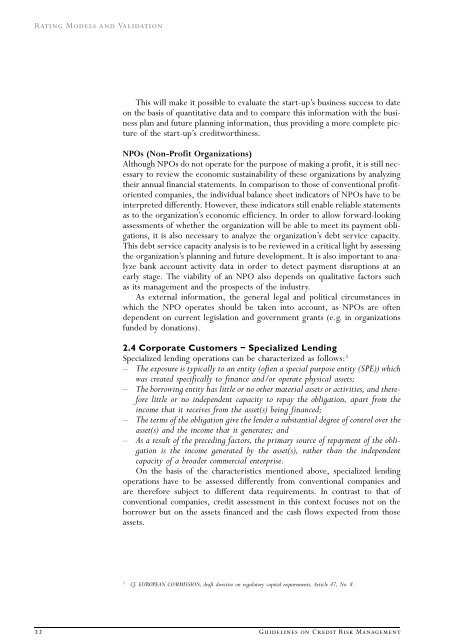Rating Models and Validation - Oesterreichische Nationalbank
Rating Models and Validation - Oesterreichische Nationalbank
Rating Models and Validation - Oesterreichische Nationalbank
You also want an ePaper? Increase the reach of your titles
YUMPU automatically turns print PDFs into web optimized ePapers that Google loves.
<strong>Rating</strong> <strong>Models</strong> <strong>and</strong> <strong>Validation</strong><br />
This will make it possible to evaluate the start-upÕs business success to date<br />
on the basis of quantitative data <strong>and</strong> to compare this information with the business<br />
plan <strong>and</strong> future planning information, thus providing a more complete picture<br />
of the start-upÕs creditworthiness.<br />
NPOs (Non-Profit Organizations)<br />
Although NPOs do not operate for the purpose of making a profit, it is still necessary<br />
to review the economic sustainability of these organizations by analyzing<br />
their annual financial statements. In comparison to those of conventional profitoriented<br />
companies, the individual balance sheet indicators of NPOs have to be<br />
interpreted differently. However, these indicators still enable reliable statements<br />
as to the organizationÕs economic efficiency. In order to allow forward-looking<br />
assessments of whether the organization will be able to meet its payment obligations,<br />
it is also necessary to analyze the organizationÕs debt service capacity.<br />
This debt service capacity analysis is to be reviewed in a critical light by assessing<br />
the organizationÕs planning <strong>and</strong> future development. It is also important to analyze<br />
bank account activity data in order to detect payment disruptions at an<br />
early stage. The viability of an NPO also depends on qualitative factors such<br />
as its management <strong>and</strong> the prospects of the industry.<br />
As external information, the general legal <strong>and</strong> political circumstances in<br />
which the NPO operates should be taken into account, as NPOs are often<br />
dependent on current legislation <strong>and</strong> government grants (e.g. in organizations<br />
funded by donations).<br />
2.4 Corporate Customers — Specialized Lending<br />
Specialized lending operations can be characterized as follows: 3<br />
— The exposure is typically to an entity (often a special purpose entity (SPE)) which<br />
was created specifically to finance <strong>and</strong>/or operate physical assets;<br />
— The borrowing entity has little or no other material assets or activities, <strong>and</strong> therefore<br />
little or no independent capacity to repay the obligation, apart from the<br />
income that it receives from the asset(s) being financed;<br />
— The terms of the obligation give the lender a substantial degree of control over the<br />
asset(s) <strong>and</strong> the income that it generates; <strong>and</strong><br />
— As a result of the preceding factors, the primary source of repayment of the obligation<br />
is the income generated by the asset(s), rather than the independent<br />
capacity of a broader commercial enterprise.<br />
On the basis of the characteristics mentioned above, specialized lending<br />
operations have to be assessed differently from conventional companies <strong>and</strong><br />
are therefore subject to different data requirements. In contrast to that of<br />
conventional companies, credit assessment in this context focuses not on the<br />
borrower but on the assets financed <strong>and</strong> the cash flows expected from those<br />
assets.<br />
3 Cf. EUROPEAN COMMISSION, draft directive on regulatory capital requirements, Article 47, No. 8.<br />
22 Guidelines on Credit Risk Management

















